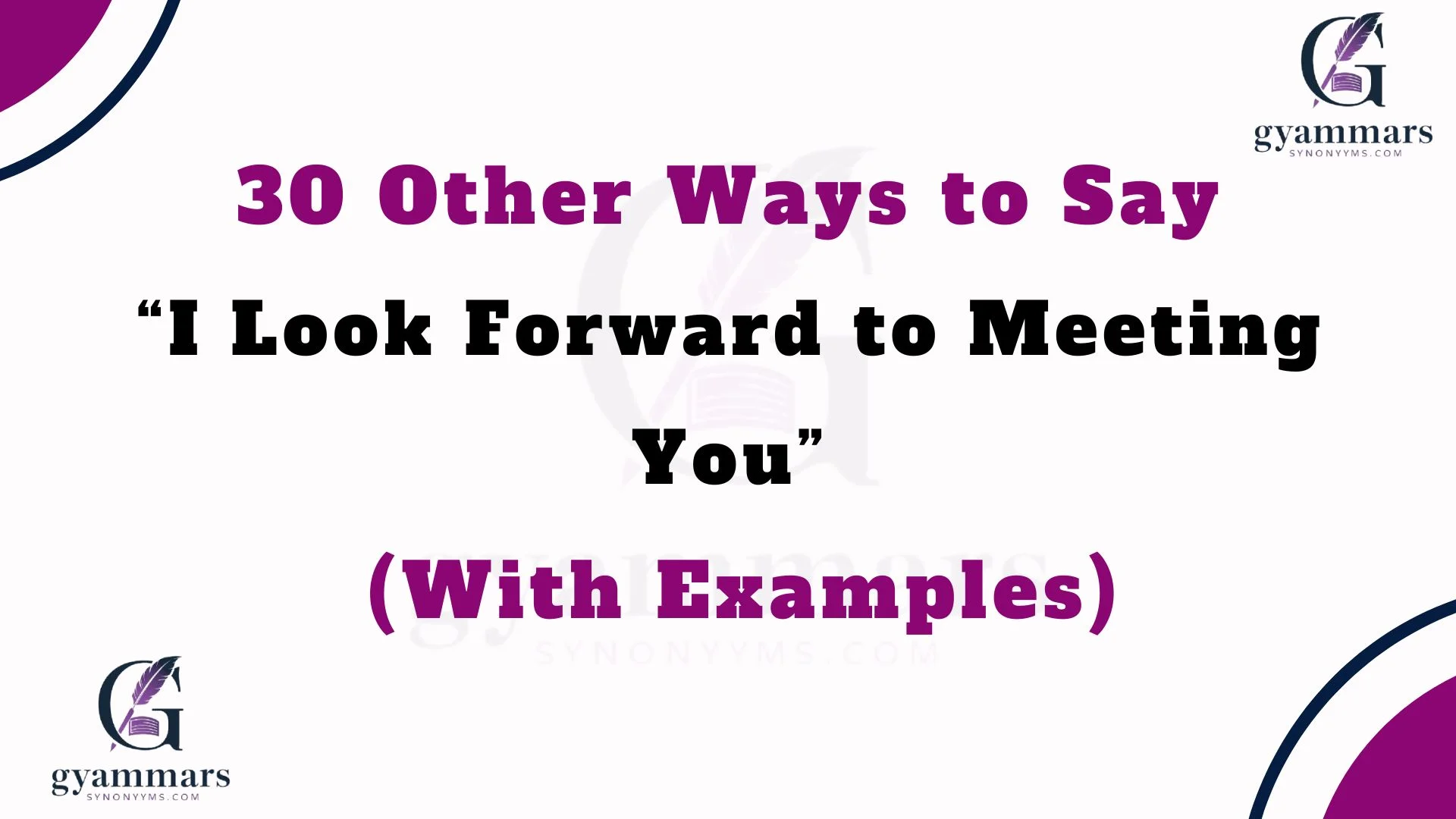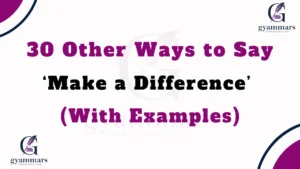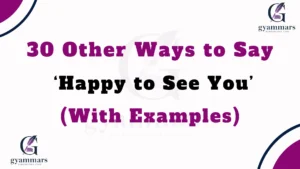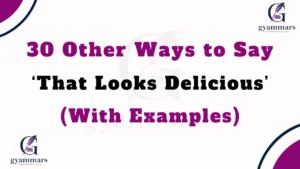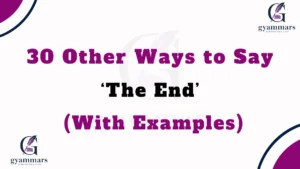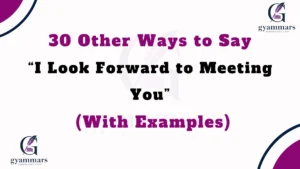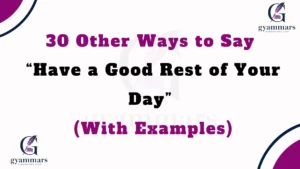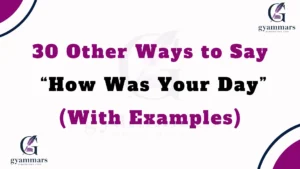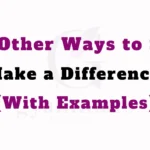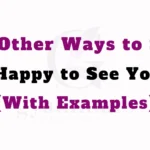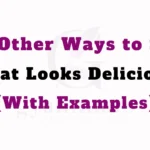Finding the right words when reaching out to someone can make all the difference. Whether you’re writing a professional email, setting up an interview, or making plans with a friend, saying “I look forward to meeting you” is warm, but sometimes it can feel overused or too formal. Using thoughtful alternatives not only shows your personality but also helps you connect in a more meaningful way.
In this article, we’ll explore 30 different ways to say “I look forward to meeting you”, complete with explanations, examples, and the best contexts for each phrase.
What Does “I Look Forward to Meeting You” Mean?
The phrase “I look forward to meeting you” is a polite and positive way of expressing anticipation and enthusiasm about seeing someone for the first time (or reconnecting). It conveys warmth, interest, and readiness for an upcoming interaction.
Is It Professional/Polite to Say “I Look Forward to Meeting You”?
Yes, it’s both professional and polite. This phrase is widely accepted in emails, networking events, and formal introductions. However, because it’s used so often, some people prefer to use synonyms or variations to sound more authentic and engaging.
Pros and Cons of Saying “I Look Forward to Meeting You”
Pros:
- Polite and universally understood
- Suitable for both professional and casual contexts
- Conveys enthusiasm and respect
Cons:
- Can sound generic or cliché due to overuse
- May lack warmth if repeated often
- Doesn’t always match informal or creative tones
Synonyms For “I Look Forward to Meeting You”
- I’m Excited to Meet You
- Can’t Wait to Meet You
- Looking Forward to Our Meeting
- I’m Eager to Meet You
- It’ll Be Great to Meet You
- I’m Looking Forward to Connecting
- Excited to Finally Meet You
- I Look Forward to Seeing You Soon
- I Anticipate Our Meeting
- Can’t Wait to See You in Person
- Thrilled to Meet You
- Looking Forward to Our Conversation
- I’m Delighted to Meet You
- I’m Looking Forward to Our Introduction
- Can’t Wait to Work With You
- Excited to Meet in Person
- Looking Forward to Collaborating
- I’m Keen to Meet You
- Happy to Finally Meet You
- I’m Looking Forward to Chatting
- Can’t Wait to Talk With You
- Excited About Our Meeting
- I’m Looking Forward to Learning From You
- Eager to Meet Face-to-Face
- I’m Looking Forward to Our Discussion
- Delighted About Our Meeting
- Anxious (in a good way) to Meet You
- I’m Looking Forward to Working Together
- Glad We’ll Be Meeting Soon
- I’m Ready and Excited to Meet You
1. I’m Excited to Meet You
Definition: Expresses genuine excitement about the upcoming meeting.
Detailed Explanation: This version feels energetic and personal, perfect for less formal situations.
Scenario Example: “I’m excited to meet you at the conference next week.”
Best Use: Networking events, informal professional meetings, friendly conversations.
Tone: Warm, enthusiastic.
Additional Notes: Avoid in very formal emails—it may feel too casual.
2. Can’t Wait to Meet You
Definition: Shows strong eagerness and anticipation.
Detailed Explanation: Slightly more casual than the original phrase, it conveys high enthusiasm.
Scenario Example: “I can’t wait to meet you in person after all our emails.”
Best Use: Informal conversations, friendly professional relationships.
Tone: Energetic, approachable.
Additional Notes: Works better when you already have some rapport.
3. Looking Forward to Our Meeting
Definition: A subtle variation of the original.
Detailed Explanation: Keeps things professional and polite while avoiding repetition.
Scenario Example: “Looking forward to our meeting on Thursday afternoon.”
Best Use: Business settings, interviews, formal introductions.
Tone: Professional, respectful.
Additional Notes: A safe, versatile choice.
4. I’m Eager to Meet You
Definition: Shows genuine anticipation.
Detailed Explanation: Slightly more formal than ‘excited’ but still friendly.
Scenario Example: “I’m eager to meet you and learn more about your project.”
Best Use: Networking, interviews, mentorship settings.
Tone: Respectful yet positive.
Additional Notes: Works well in emails to higher-ups or clients.
5. It’ll Be Great to Meet You
Definition: A casual, optimistic phrasing.
Detailed Explanation: This phrase expresses confidence that the meeting will be pleasant.
Scenario Example: “It’ll be great to meet you at the company mixer.”
Best Use: Social events, casual networking.
Tone: Friendly, easygoing.
Additional Notes: Not ideal for formal business letters.
6. I’m Looking Forward to Connecting
Definition: A broader term that emphasizes building a relationship.
Detailed Explanation: Works well when the focus is on networking or collaboration.
Scenario Example: “I’m looking forward to connecting and discussing potential opportunities.”
Best Use: Professional networking, LinkedIn messages.
Tone: Professional, collaborative.
Additional Notes: Less formal than “meeting,” more open-ended.
7. Excited to Finally Meet You
Definition: Highlights anticipation after prior communication.
Detailed Explanation: A great choice if you’ve been emailing or messaging someone for a while.
Scenario Example: “Excited to finally meet you after all our calls!”
Best Use: When transitioning from online to in-person.
Tone: Warm, authentic.
Additional Notes: Adds a personal touch.
8. I Look Forward to Seeing You Soon
Definition: Similar to the original but with a warmer twist.
Detailed Explanation: Suitable for both professional and casual use.
Scenario Example: “I look forward to seeing you soon at the workshop.”
Best Use: Hybrid of professional and friendly contexts.
Tone: Neutral, kind.
Additional Notes: Good when you already know the person slightly.
9. I Anticipate Our Meeting
Definition: More formal and intellectual sounding.
Detailed Explanation: Best for highly professional or academic settings.
Scenario Example: “I anticipate our meeting to discuss the partnership agreement.”
Best Use: Business negotiations, formal letters.
Tone: Formal, polished.
Additional Notes: Can feel stiff in casual use.
10. Can’t Wait to See You in Person
Definition: Emphasizes face-to-face interaction.
Detailed Explanation: Ideal when you’ve interacted virtually before.
Scenario Example: “Can’t wait to see you in person after working together remotely.”
Best Use: Online-to-offline meetings.
Tone: Friendly, cheerful.
Additional Notes: Avoid in formal client communication.
11. Thrilled to Meet You
Definition: A strong, enthusiastic way to show excitement.
Detailed Explanation: The word “thrilled” communicates joy and eagerness, making the message very warm.
Scenario Example: “I’m thrilled to meet you at the book signing.”
Best Use: Social, casual, or semi-professional settings.
Tone: Very enthusiastic, upbeat.
Additional Notes: Avoid in very formal emails—it may sound overly casual.
12. Looking Forward to Our Conversation
Definition: Focuses on the discussion aspect of the meeting.
Detailed Explanation: Great if you want to highlight an exchange of ideas.
Scenario Example: “I’m looking forward to our conversation about the new project.”
Best Use: Professional or networking settings.
Tone: Neutral, respectful.
Additional Notes: Keeps the tone professional yet approachable.
13. I’m Delighted to Meet You
Definition: Expresses polite happiness.
Detailed Explanation: A classic alternative, perfect for when you want to sound gracious and warm.
Scenario Example: “I’m delighted to meet you and discuss your vision.”
Best Use: Formal meetings, business introductions.
Tone: Courteous, refined.
Additional Notes: Timeless choice for professional emails.
14. I’m Looking Forward to Our Introduction
Definition: Highlights the act of being formally introduced.
Detailed Explanation: Works well when someone is arranging the meeting for you.
Scenario Example: “I’m looking forward to our introduction at the board meeting.”
Best Use: Formal introductions, networking.
Tone: Polite, professional.
Additional Notes: Best when someone else is setting up the connection.
15. Can’t Wait to Work With You
Definition: Shows eagerness for collaboration.
Detailed Explanation: More specific than the original, this phrase emphasizes teamwork.
Scenario Example: “I can’t wait to work with you on this project.”
Best Use: Work emails, project collaborations.
Tone: Collaborative, positive.
Additional Notes: Great for new colleagues or clients.
16. Excited to Meet in Person
Definition: Highlights the face-to-face element.
Detailed Explanation: Works well when you’ve had previous online or phone conversations.
Scenario Example: “Excited to meet in person after months of working remotely.”
Best Use: Online-to-offline connections.
Tone: Warm, personable.
Additional Notes: Good for both friendly and professional settings.
17. Looking Forward to Collaborating
Definition: Emphasizes joint work.
Detailed Explanation: Great when the upcoming meeting is about partnerships or projects.
Scenario Example: “Looking forward to collaborating on the new marketing strategy.”
Best Use: Business, teamwork, project planning.
Tone: Professional, cooperative.
Additional Notes: Shows proactive and team-oriented spirit.
18. I’m Keen to Meet You
Definition: A slightly formal way to show interest.
Detailed Explanation: The word “keen” communicates a respectful eagerness.
Scenario Example: “I’m keen to meet you and hear your perspective.”
Best Use: Professional or semi-formal.
Tone: Polite, professional.
Additional Notes: More common in British English.
19. Happy to Finally Meet You
Definition: Expresses both relief and joy.
Detailed Explanation: Perfect for when you’ve known someone virtually or indirectly for a while.
Scenario Example: “Happy to finally meet you after working together for months.”
Best Use: Casual-professional, personal introductions.
Tone: Friendly, sincere.
Additional Notes: Adds warmth and familiarity.
20. I’m Looking Forward to Chatting
Definition: Focuses on the conversation element in a relaxed tone.
Detailed Explanation: Less formal, this phrase feels casual and approachable.
Scenario Example: “I’m looking forward to chatting about your ideas.”
Best Use: Informal business settings, friendly connections.
Tone: Relaxed, warm.
Additional Notes: Best for casual networking or friendly emails.
21. Can’t Wait to Talk With You
Definition: Shows strong eagerness for a discussion.
Detailed Explanation: Slightly more energetic than “looking forward to chatting.”
Scenario Example: “Can’t wait to talk with you about your new project.”
Best Use: Semi-professional, friendly.
Tone: Warm, approachable.
Additional Notes: Not ideal for very formal communication.
22. Excited About Our Meeting
Definition: Highlights anticipation about the actual event.
Detailed Explanation: Balanced tone—enthusiastic but not too casual.
Scenario Example: “I’m excited about our meeting next Tuesday.”
Best Use: Professional meetings, interviews, networking.
Tone: Neutral, friendly.
Additional Notes: Works in both personal and work-related settings.
23. I’m Looking Forward to Learning From You
Definition: Shows respect and humility.
Detailed Explanation: Ideal when meeting someone more experienced or knowledgeable.
Scenario Example: “I’m looking forward to learning from you during our workshop.”
Best Use: Mentorship, interviews, academic meetings.
Tone: Respectful, professional.
Additional Notes: Adds sincerity and admiration.
24. Eager to Meet Face-to-Face
Definition: Focuses on the physical meeting aspect.
Detailed Explanation: Perfect for people you’ve only interacted with online.
Scenario Example: “I’m eager to meet face-to-face after months of emails.”
Best Use: Online connections turning into in-person.
Tone: Warm, friendly.
Additional Notes: Adds a human touch.
25. I’m Looking Forward to Our Discussion
Definition: Highlights the exchange of ideas.
Detailed Explanation: Ideal for professional or intellectual conversations.
Scenario Example: “I’m looking forward to our discussion on sustainability.”
Best Use: Business, academic, research contexts.
Tone: Professional, serious.
Additional Notes: Shows focus and respect.
Also Read This : 30 Other Ways to Say “Have a Good Rest of Your Day” (With Examples)
26. Delighted About Our Meeting
Definition: Similar to “excited,” but more polished.
Detailed Explanation: Perfect for maintaining professional courtesy with warmth.
Scenario Example: “I’m delighted about our meeting later this week.”
Best Use: Business and formal introductions.
Tone: Polite, respectful.
Additional Notes: Adds elegance without stiffness.
27. Anxious (in a good way) to Meet You
Definition: Shows a mix of nervous excitement and eagerness.
Detailed Explanation: Best for personal or friendly contexts, as it’s more emotional.
Scenario Example: “I’m a little anxious (in a good way) to meet you tomorrow.”
Best Use: Personal connections, dating, casual friendships.
Tone: Vulnerable, authentic.
Additional Notes: Avoid in professional settings.
28. I’m Looking Forward to Working Together
Definition: Strongly emphasizes future collaboration.
Detailed Explanation: Great for workplace relationships or new partnerships.
Scenario Example: “I’m looking forward to working together on this campaign.”
Best Use: New jobs, client onboarding, partnerships.
Tone: Collaborative, professional.
Additional Notes: Builds trust and cooperation.
29. Glad We’ll Be Meeting Soon
Definition: Expresses calm, pleasant anticipation.
Detailed Explanation: Softer than “excited,” but still positive.
Scenario Example: “I’m glad we’ll be meeting soon to finalize details.”
Best Use: Neutral settings, semi-formal interactions.
Tone: Gentle, polite.
Additional Notes: Works across professional and casual contexts.
30. I’m Ready and Excited to Meet You
Definition: Combines readiness and enthusiasm.
Detailed Explanation: Perfect for when you want to show both preparation and positivity.
Scenario Example: “I’m ready and excited to meet you and kick off this project.”
Best Use: Business partnerships, project launches, interviews.
Tone: Confident, enthusiastic.
Additional Notes: Balanced—neither too casual nor too stiff.
Conclusion
Choosing the right words makes your message feel more genuine and personal. Instead of sticking to the standard “I look forward to meeting you,” these 30 alternatives let you adjust your tone—whether you want to sound professional, casual, or deeply enthusiastic. By tailoring your language, you can build stronger connections and leave a lasting impression.
FAQs
1. What’s the warmest alternative to “I look forward to meeting you”?
“Thrilled to meet you” or “Excited to finally meet you” add more warmth.
2. Which alternative is best for business?
“Looking forward to our meeting” or “I anticipate our meeting” work best in formal settings.
3. Can I use casual alternatives in work emails?
Yes, but only with colleagues or when the relationship is already friendly.
4. How do I avoid sounding repetitive?
Vary your phrases and tie them to the context, e.g., “Looking forward to collaborating.”
5. Is “Can’t wait to meet you” too informal?
It’s fine with peers or friends but avoid it with new clients or executives.

“Emma Brooke at Grammar Synonyms is your trusted source for mastering the art of language. Whether you’re looking for the perfect synonym, refining your grammar, or searching for that one ideal phrase, we’ve got you covered. With a wealth of tools and resources, Emma Brooke brings you creative solutions for all your writing needs, making sure your words always hit the mark. Unlock a world of language possibilities and elevate your writing with ease.”
